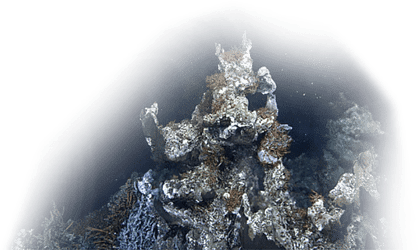The arrival of the historic Canada Coast-to-Coast-to-Coast (Canada C3) expedition and Fish Eye Project’s Arctic live dive event⎯broadcast across the nation on Sunday 27 August⎯turns a tiny Nunavut hamlet into an innovative ocean literacy and climate science hub.
Figure 1. Members of the Fish Eye Project team prepare for the Arctic live dive as the Canada C3 ship arrives in Cambridge Bay, Nunavut.
For the first time in Canadian history, a group of marine biologists, educators and divers successfully broadcast live across the country from the frigid Arctic Ocean (Figure 1). On Sunday, 27 August, Victoria-based Fish Eye Project climbed aboard the Canada C3 ice breaker in Cambridge Bay and hosted a broadcast that provided Canadians with an opportunity to experience a glimpse of Arctic marine life (Figure 2).
Figure 2. The Arctic live dive was broadcast from the Canada C3 ship. Live dive hosts (l-r): Dr. Philippe Archambault, Laval University; Fish Eye Project team member Philippe Daigle, and co-founder Mike Irvine; Canada C3 expedition leader Geoff Green; and representing both the Cambridge Bay community and Ocean Networks Canada, Mia Otokiak with her grandmother Eva Otokiak. Photo: Students on Ice Foundation/Natta Summerky.
The English and French live dives⎯streamed live on CanadaC3 Facebook page⎯were viewed close to 200,000 times in less than a week. See for yourself!
Watch the French version here.
Ocean Networks Canada (ONC) was proud to sponsor this innovative opportunity to help Canadians understand and experience the Arctic Ocean. Victoria-based Fisheye Project founders Mike Irvine and Maeva Gauthier (Figure 3) are both University of Victoria alumni. Fish Eye Project connects people to the world’s ocean through interactive live dives. Participants can see, hear, and talk to scuba divers, in real time, without getting wet.
Figure 3. Fish Eye Project co-founders Maeva Gauthier and Mike Irvine prepare for the Arctic live dive. Photo credit: Students on Ice Foundation/Natta Summerky
quote“ONC was instrumental in making this Arctic live dive possible,” says Fish Eye Project co-founder Maeva Gauthier. “Fish Eye is proud to have partnered with ONC to connect tens of thousands of Canadians with the Arctic Ocean and share the amazing biodiversity in these waters. ONC’s connections with the Cambridge Bay community and the Canadian High Arctic Research Station (CHARS), ocean education background, and knowledge of the marine life in these waters were very helpful. POLAR Knowledge Canada and CHARS have been very helpful locally and Ocean Wise provided us with dive gear.”
Twenty-year old Mia Otokiak, ONC’s first Youth Science Ambassador (2016-2017) was the star of the show, speaking on behalf of the Cambridge Bay community and ONC at both the Arctic live dive and the Canada C3 welcome ceremony (Figure 4).
Figure 4. Mia Otokiak spoke confidently and eloquently on behalf of both her local community and ONC at the Arctic live dive (left, centre) and at the Canada C3 welcome ceremony (right). Photo credit (left) Students on Ice Foundation/Natta Summerky.
The Honourable Marc Garneau, Minister of Transport was also in Cambridge Bay to greet the arrival of Canada C3 and to make a funding announcement (Figure 5). Over the next 5 years, $175 million will be invested for Arctic Ocean initiatives, including safety equipment, marine infrastructure and training in Arctic coastal communities; an "Arctic National Aerial Surveillance Program Complex" in Iqaluit to allow for increased surveillance capabilities over the growing number of ships in the north; the establishment of an office of incident management through Transport Canada; expansion of Transport Canada's Community Participation Funding Program; and expansion of the Canadian Coast Guard Auxiliary in the Arctic. Support for these initiatives will be allocated out of the government's $1.5 billion Oceans Protection Plan announced in November 2016.
Figure 5. Canada C3 expedition leader Geoff Green gives the Honourable Marc Garneau, Minister of Transport a tour of Canada C3’s Legacy Room. Minister Garneau is holding a model of the carved wooden figure that travels by canoe through the Great Lakes to the Atlantic Ocean in Holling Clancy Holling's illustrated classic ‘Paddle to the Sea’. Mr. Green has promised to float the carving in the water off all three coasts during the expedition. Photo credit (left) Students on Ice Foundation/Natta Summerky.
The Honourable Catherine McKenna, Canada’s Minister of Environment and Climate Change watched the dive online and tweeted about her desire to participate in a future live dive (Figure 6).
Figure 6. The Honourable Catherine McKenna, Minister of the Environment and Climate Change, expresses her interest in participating in a future Fish Eye Project live dive. Stay tuned!
Meanwhile, the ONC team are in Cambridge Bay from 3-15 September to conduct annual maintenance and upgrades to ONC’s underwater arctic observatory and shore station, now in its fifth year of gathering continuous Arctic Ocean and sea ice data.
At the same time, ONC’s Learning and Engagement team will be further developing ONC’s relationships with local schools and community groups, while the team fosters ongoing collaborations with international Arctic research initiatives at the recently completed Canadian High Arctic Research Station (CHARS), which will officially open in October 2017.
RELATED STORIES
- Cambridge Bay at the Crossroads of History and Climate Science
- The Great Thaw: our melting Arctic must be monitored and Canada should lead the way
- Arctic Sea Ice: Slow Growth in 2016
- Cambridge Bay Observatory Monitors Arctic Ocean Health and Safety
- Mia Otokiak, ONC’s New Arctic Youth Science Ambassador
